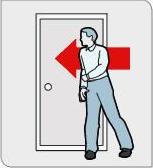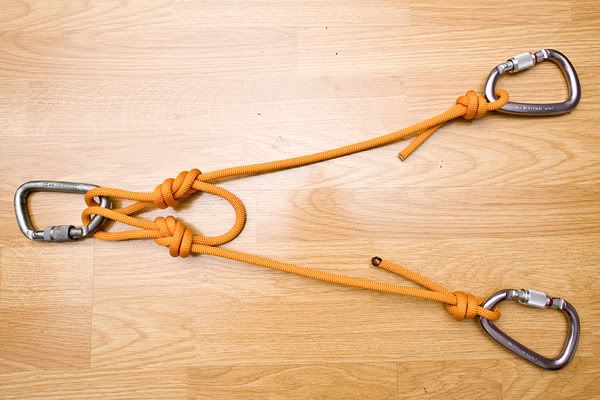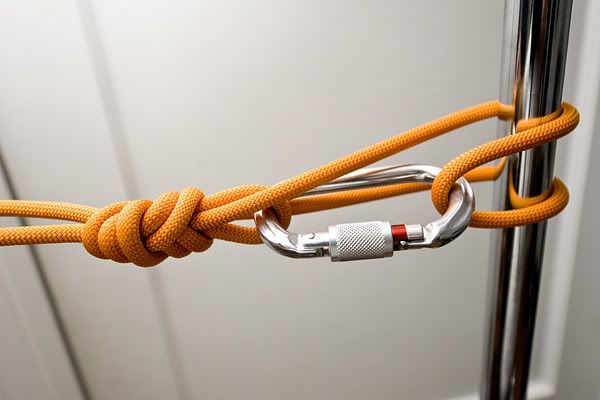 |
 |
|
UER Store
|
|
 order your copy of Access All Areas today!
order your copy of Access All Areas today!
|
|
 |
 MindHacker
   
Location: Suburbs of DC
Gender: Male

If you spot a terrorist arrow, pin it to the wall with your shoulder.
 | |  | Re: a guide to basic rope work
<Reply # 60 on 9/20/2010 12:00 AM >
|  | | | Ladders and railings. Railings are always great. I've also used mounting points for industrial winches and elevators.
Those AC units would be fine to anchor to, as long as you go for a main structural member, and not a vent or tube. If you consider thoughtfully you should be fine.
I'd set up a redundant anchor with some webbing (cams are great for rockclimbing, but they pale in comparison to a real anchor) and it will be bulletproof. Let us know if you don't know how to make/use webbing runners, or how to tie in, and we'll be glad to fill you in.
"That's just my opinion. I would, however, advocate for explosive breaching, since speed and looking cool are both concerns in my job."-Wilkinshire |
|
vov35
 
Location: Maryland
Gender: Male

 | |  | Re: a guide to basic rope work
<Reply # 61 on 9/20/2010 11:21 PM >
|  | | | Posted by MindHacker
Ladders and railings. Railings are always great. I've also used mounting points for industrial winches and elevators.
Those AC units would be fine to anchor to, as long as you go for a main structural member, and not a vent or tube. If you consider thoughtfully you should be fine.
I'd set up a redundant anchor with some webbing (cams are great for rockclimbing, but they pale in comparison to a real anchor) and it will be bulletproof. Let us know if you don't know how to make/use webbing runners, or how to tie in, and we'll be glad to fill you in.
|
I'm quite skilled in that, but I'm not sure as to what you define as a proper anchor on a building. 
Those AC units are pretty heavy so I'd assume the beam under them is solid.
"Only sheep need a shepherd." -- Voltaire |
|
Caste

Location: Toronto, Canada
Gender: Male
 | |  | Re: a guide to basic rope work
<Reply # 62 on 9/24/2010 4:48 PM >
|  | | | Hey, I've got a few questions after looking through the rope threads on this forum and even online, the first being, what would be a decent harness setup for climbing ladders/securing yourself when on a high place? I'm assuming some sort of harness, a short static line and a carabiner? What do people generally use when they want to clip in to a railing or ladder rung when taking a break while climbing?
The second being, how exactly does retrieving rope after a descent work? I've been looking into getting introduced into some ice climbing this winter, maybe learn some basic rock climbing ropework before, but say you'd get a rope onto a raised ladder via attaching it to one of those nerf football things that someone posted, how would it be secured in a way that when you descend from it after the climb, you could retrieve it? Would I be correct in assuming that you can only retrieve everything when using a natural anchor, rather than an elaborate rope/equipment setup?
[i]"The sharpest sword cannot compare to the sharpest mind"[/i] |
|
vov35
 
Location: Maryland
Gender: Male

 | |  | Re: a guide to basic rope work
<Reply # 63 on 9/24/2010 7:54 PM >
|  | | | Posted by Caste
Hey, I've got a few questions after looking through the rope threads on this forum and even online, the first being, what would be a decent harness setup for climbing ladders/securing yourself when on a high place? I'm assuming some sort of harness, a short static line and a carabiner? What do people generally use when they want to clip in to a railing or ladder rung when taking a break while climbing?
The second being, how exactly does retrieving rope after a descent work? I've been looking into getting introduced into some ice climbing this winter, maybe learn some basic rock climbing ropework before, but say you'd get a rope onto a raised ladder via attaching it to one of those nerf football things that someone posted, how would it be secured in a way that when you descend from it after the climb, you could retrieve it? Would I be correct in assuming that you can only retrieve everything when using a natural anchor, rather than an elaborate rope/equipment setup?
|
I'd use a dynamic line for climbing, even if it's for resting while freeclimbing a ladder. if you fall it absorbs the shock, but they don't stretch so far as to be an issue for putting your weight on them if they're short. You're supposed to use static line for abseils, I've only used dynamic and it's been just fine.
Get a screw gate locking climbing 'biner, you can leave the gate unscrewed if you're going to be moving your anchor frequently. (this reduces it's load bearing, but damnit you're using a short dynamic line for a reason)
Do NOT go and put your life on a line without IRL rock climbing ropework training. It's a bad fucking idea.
Learn to tie a swiss seat if you're super cheap (or me and have no goddamn money), or just get a cheap rock climbing harness. You retrieve the rope by rappelling down to parallel lengths and then pulling one through when you're done. (or that's how I've been doing it...
</ROCK climbing exp> lol
"Only sheep need a shepherd." -- Voltaire |
|
Caste

Location: Toronto, Canada
Gender: Male
 | |  | Re: a guide to basic rope work
<Reply # 64 on 9/24/2010 9:22 PM >
|  | | | Alright, thanks for the info. I wasn't planning on doing anything crazy until I learn from a professional, but I was looking to invest some money into a comfortable rock climbing harness and learning some basic ropework just for that extra safety. Up until now I've been climbing cranes and silos, among other things, with absolutely no protection for far too long.
[i]"The sharpest sword cannot compare to the sharpest mind"[/i] |
|
vov35
 
Location: Maryland
Gender: Male

 | |  | Re: a guide to basic rope work
<Reply # 65 on 9/25/2010 12:50 AM >
|  | | | You could probably buy everything from the internet pretty cheaply, I guess you may want to test fit a harness. But yeah, good starting gear would be a good length of dynamic rope, an atc, a harness, and a set of 'biners. webbing wouldn't hurt, and then ascenders if you're planning on going up the rope... **lets somebody more experienced continue**
"Only sheep need a shepherd." -- Voltaire |
|
delusional
   
Location: Hamilton, Ontario
Gender: Male

 | |  | Re: a guide to basic rope work
<Reply # 66 on 9/25/2010 1:44 AM >
|  | | | Posted by vov35
You could probably buy everything from the internet pretty cheaply, I guess you may want to test fit a harness. But yeah, good starting gear would be a good length of dynamic rope, an atc, a harness, and a set of 'biners. webbing wouldn't hurt, and then ascenders if you're planning on going up the rope... **lets somebody more experienced continue**
|
Where is a reputable source to buy all these things online? Im having a bit a trouble finding a good one 
|
|
vov35
 
Location: Maryland
Gender: Male

 | |  | Re: a guide to basic rope work
<Reply # 67 on 9/25/2010 1:54 AM >
|  | | | Go for anything made by a big climbing brand name.
"Only sheep need a shepherd." -- Voltaire |
|
PositivePressure
 
Location: High and low where most don't go
Gender: Male

Set your Tesla coil to broil
 | |  | Re: a guide to basic rope work
<Reply # 68 on 9/25/2010 2:07 AM >
|  | | | If you're looking at a really basic setup just for safety while climbing structures and work positioning, I'd just grab a simple seat harness, some good dynamic rope, and some biners. From that you can make up some cowstails to keep yourself connected to whatever you're hanging from. You could even pick up some scaffold hooks if you want to be real snazzy while on ladders and such.
If you're going to get into SRT/rappelling and the like, what you end up getting will depend on your intended use. But you'll want to pick up a descender (ATC types are probably the best and safest option for a beginner), some prusik cord, and a good amount of webbing for a very basic setup. Of course, you'll need biners and rope, too.
Knots, knots, knots. Knots. Learn your knots! Learn them to the point that you can tie them with your eyes closed, behind your back. Know the advantages and disadvantages of each. Your anchors and the knots with which you construct them are your lifeline and you want to know them inside and out - Your life depends on it! You also need to know how to get yourself out of a sticky situation when you find yourself in one. Practice self rescue while hanging from a tree, a short ledge, anywhere before you get yourself out on a real pitch. Practice transitioning from ascent to rappel, and visa versa. And while doing all this, try to learn while using only the most basic equipment - your ropes and cordage - before you pick up anything mechanical to make life easier.
I would strongly recommend that you find someone who can spend some time to show you these things in person, if at all possible. But, any questions at all, feel free to ask.
|
|
Caste

Location: Toronto, Canada
Gender: Male
 | |  | Re: a guide to basic rope work
<Reply # 69 on 9/25/2010 4:53 AM >
|  | | | Wow, thanks for all of the info haha, I'm still wondering though, what size/length of dynamic rope would I be looking at, just for a safety line coming off of a harness? Would I be doing it straight out of the harness onto the carabiner/hook or do people usually 'double' the rope up and knot it so that its got more strength/less distance from the point that it's clipped onto. As for the scaffold hooks, do they provide any disadvantage over the carabiners? They seem like a more efficient way at quickly attaching yourself to something, from what I've seen you can just clip in quickly and have an enclosed connection, rather than an unscrewed carabiner if you're taking a short break on a ladder.
Also, I did a search on cows tails and came up with http://sites.googl...ts/kit/cow-s-tails 
Is the overhand knot the bit that would be connected to the harness, giving two points of connection? It's really hard to visualize some of these concepts without too much prior knowledge, and I'm really not trying to get myself into anything that's way ahead of me without proper firsthand training.
[i]"The sharpest sword cannot compare to the sharpest mind"[/i] |
|
PositivePressure
 
Location: High and low where most don't go
Gender: Male

Set your Tesla coil to broil
 | |  | Re: a guide to basic rope work
<Reply # 70 on 9/25/2010 5:57 AM >
|  | | | No problem 
As far as size of rope goes... its sort of personal preference. I've got cowstails hanging around that I've made from 11mm and some from skinnier 9mm rope. Usually it ends up being just spare sections of whatever dynamic stuff you've got kicking around that'll do the job. Everyone has their own preference as far as how long they like their cowstails, too. A lot of people like them to be around arm's length, some like them shorter. The longer they are, the better they are going to absorb the shock from a potential fall. Generally arm's length is good. Some prefer to have one side shorter than the other, while some like to have both sides equal.
When you hook everything up, you want your cowstail to be attached directly to your harness' load loop, connected via carabiner. There really isn't any reason to be doubling anything up if you've built your cowstail the right way. Its plenty strong. In your picture, the overhand knot is what would attach to your harness.
Here's an example of how I make mine. Its far more secure than the overhand knot version you've got pictured there. Obviously this one I made with both lengths equal, but you can make one side longer if you want.

Basically you've got two connected figure-8s at the harness end which both clip into your load loop via a carabiner (shown). This ensures that both sides are independent of each other. If one somehow fails, you've got your second one as a backup. You arent relying on a single point. I see a lot of people make them with a single overhand knot, but this method offers twice the security and uses only a bit more rope. From there, your two sides come out and you bring the rope back and tie a fisherman's knot back into itself. These loops are where your carabiners get placed (also shown).
Which brings us to scaffold hooks. The advantage scaffold hooks have is that they can fit around larger rungs and objects, while being auto-locking, whereas the gate opening on most carabiners is far too small and most require screw closure.
There is, however, a method to create a cowstail with a quick attaching end that can save you some time:

As you can see, the topmost end has been changed. What I've done is made a double figure 8 instead of the fisherman's knot and adjusted the two loops so we've got one large loop and one small loop. You then attach a carabiner to your smaller loop, and you're good to go:

While still requiring screw closure, you can clip more quickly into much larger safe points along your route. The key with this setup is just to ALWAYS make sure that your long loop is long enough so that your carabiner isn't resting (and then possibly loaded/forced) against the object you're attaching to.
|
|
Caste

Location: Toronto, Canada
Gender: Male
 | |  | Re: a guide to basic rope work
<Reply # 71 on 9/25/2010 6:43 AM >
|  | | | Wow, thank you very much for all of that, very very detailed and informative. The cowstail seems like it's a lot safer and more efficient than some of the simpler methods that I was thinking of, will definitely have to spend time learning how to get the knots secure when I get the rope, but it looks like it'd be especially good for having a cable ascender and a carabiner or scaffold hook when climbing something that has cable on/off, but I also really like the last method you showed, with the larger loop. Would it be strongly suggested that one redoes these rope setups every time they go out?
[i]"The sharpest sword cannot compare to the sharpest mind"[/i] |
|
\/adder
    
Location: DunkarooLand
Gender: Male

I'm the worst of the best but I'm in this race.
 | |  | |  | Re: a guide to basic rope work
<Reply # 72 on 9/25/2010 1:46 PM >
|  | | | Balance and paying attention to what you are doing are the best forms of fall protection...
But I'd recommend untying and retying knots just because it's better for the rope if you store it untied.
I use a 10' section of 8mm static doubled up which leaves about an arms length. (the static vs dynamic doesn't matter for a fall of 5' the danger is in momentum and kinetic force, which won't build up enough over a short fall to make a difference.)
You don't want to fall somewhere you can't reach to pull yourself up and you don't want to be unable to preform self rescue.
If you are using dynamic line, calculate the stretch potential and subtract that from the arms length. (typically ~30%)
This is why I don't use industry standard shock-absorbing lanyards the likelihood of over-expansion and falling somewhere you can't get back up is too great (those things will expand up to 2-3 times in overall length)
Professional(legal) climbers can afford to wait around all day for a rescue ... recreational(illegal) climbers don't have the same luxury.
I'll take my odds of rated rope failing over going to jail if I get stuck using something OSHA standards guarantee will save me 100% of the time.
"No risk, no reward, no fun."
"Go all the way or walk away"
escensi omnis... |
|
PositivePressure
 
Location: High and low where most don't go
Gender: Male

Set your Tesla coil to broil
 | |  | Re: a guide to basic rope work
<Reply # 73 on 9/25/2010 1:48 PM >
|  | | | Any time. The only thing you want to watch is how you're using them. Their main purpose is for work positioning and being able to hang from things under a static load. While they are made of dynamic rope, you never want to put yourself in a situation where they could be shock loaded a great deal. Their biggest fallback is the fact that the end carabiners are attached via the fisherman's knots - which are weaker than figure 8s under a shock load condition. So simply put, don't rely on them for fall arrest any time you're going to be moving above your clip in point. They would likely hold up, provided you don't take a big fall or something, but just keep that in mind. If you're going to be pulling a cable ascender alongside you up a ladder, I'd almost say you'd be better off getting a beefy length of dynamic, tying a figure 8 in both ends, and using that to attach to the cable ascender, simply because the figure 8 is better at absorbing (and surviving) falls.
As far as retying them every time - its not necessary if the rope is never going to be used for anything else. Stationary knots left tied won't really weaken the rope unless you untie it and want to use it for something else. That's when you've got to worry about how strong the previously knotted points are. Once you load the system with your body weight a few times, those fisherman's knots are pretty difficult - sometimes near impossible - to untie. What you DO want to do though, is always check your stuff before use. Make sure the rope is intact and safe to use. If you take a fall onto it, or its starts to show wear, make a new one.
[last edit 9/25/2010 1:52 PM by PositivePressure - edited 1 times]
|
|
Caste

Location: Toronto, Canada
Gender: Male
 | |  | Re: a guide to basic rope work
<Reply # 74 on 9/25/2010 8:21 PM >
|  | | | Hm, so what would be suggested for cranes, where if I fall it'll be a hard fall with all my weight going onto the rope and me most likely hanging in limbo, would your suggestion of beefy dynamic attached with figure 8's to each end be suggested in places where any fall would result in going straight down.
[i]"The sharpest sword cannot compare to the sharpest mind"[/i] |
|
PositivePressure
 
Location: High and low where most don't go
Gender: Male

Set your Tesla coil to broil
 | |  | Re: a guide to basic rope work
<Reply # 75 on 9/25/2010 8:58 PM >
|  | | | The idea behind using cowstails is that you'd be clipping into incremental safe points when you want to rest or hang in space for photos, etc. It wouldn't be practical to be constantly clipping into things every few feet for the entire climb. It would take forever. Therefore in a crane situation they're only really for use when you want to hang out for a bit, or feel you need to stop and secure yourself in place for some reason, such as a really long drawn out climb with nowhere to rest. Its assumed that you will be doing some "unprotected" climbing.
That being said, most cranes, regardless of height, are pretty low risk as you'll be climbing inside the central column, surrounded by the steel cross section, and each level is often pretty short (10m or so) before you reach a floor section where you can stop and rest. If you had to climb the entire thing as one continuous ladder with nowhere to stop, then that's a situation that would call for cowstails to hang from and rest. If you were climbing something that had a safety cable, such as a water tower or bridge or similar, and you had a cable fall arrest device, that's when I'd use the figure 8s on a single short rope attached to the device. Otherwise though, I'd just free-climb it and have the cowstail on standby if you brought it. Again, I'd likely only use it if I wanted to stop and hang to direct my attention to other things like photos.
Its usually less hazardous to trust your own grip and instincts than it is to rely on and constantly be adjusting gear in order to protect yourself. Two hands on the rungs and your full attention is safer than one hand on the rung and the other fumbling around with biners and junk. Simplicity is safety.
|
|
Caste

Location: Toronto, Canada
Gender: Male
 | |  | Re: a guide to basic rope work
<Reply # 76 on 9/26/2010 1:42 AM >
|  | | | Oh I've done cranes, lots of them, I'm talking about going out on the edge of the frame where the crane's load is secured, I'd like something that I can use to clip into a part of the frame so that if something should happen I don't fall off and die 
[i]"The sharpest sword cannot compare to the sharpest mind"[/i] |
|
\/adder
    
Location: DunkarooLand
Gender: Male

I'm the worst of the best but I'm in this race.
 | |  | |  | Re: a guide to basic rope work
<Reply # 77 on 9/26/2010 2:17 AM >
|  | | | Posted by Caste
Oh I've done cranes, lots of them, I'm talking about going out on the edge of the frame where the crane's load is secured, I'd like something that I can use to clip into a part of the frame so that if something should happen I don't fall off and die 
|
You can use slings or rope. I prefer slings now.
This was my old setup:

You should probably use a carabiner and don't loop the sling through the harness because it may compromise the strength of the sling (the picture from someone asking me about the absolute cheapest way to do it.)

In searching for this link I came across this;
http://www.ems.com...?productId=3659423
^combine this with a nice big autolocking carabiner or scaffolding 'biner and you'd be all set.
"No risk, no reward, no fun."
"Go all the way or walk away"
escensi omnis... |
|
MindHacker
   
Location: Suburbs of DC
Gender: Male

If you spot a terrorist arrow, pin it to the wall with your shoulder.
 | |  | Re: a guide to basic rope work
<Reply # 78 on 9/27/2010 5:37 AM >
|  | | | Re: Static vs Dynamic: For the distance you're falling, it won't make a difference. Dynamic is nominally the correct answer, but it practice it won't make a difference.
Rope size: Also doesn't make a difference. 5mm would be sufficient because you won't be able to generate much force on a 3' fall. I use quickdraws because I'm not clipping in while climbing (I'll clip to a wire so I can't fall out/away, just down 15' at a time, It's never happened). It's nice to have a size you can use to rest, especially if it leaves arms free to work a camera.
Harness: If you're just using it for safety a basic webbing harness is fine, and very adjustable to fit most sizes. If you know what to look for and inspect your gear, you can get good stuff off ebay. Just make sure to double-back over the buckles and tie in through the waist and leg loops.
Scaffolding hooks: Good to have, but rarely useful, and heavy as f*ck. Make sure you take a regular biner too, because you'll want to avoid using the hook if possible. It's basically for the situations when you don't have any actual points that are supposed to be clipped into, and are left needing to clip into a railing. I like positive-pressures idea though. Even though you can find them for about 20$, I'd do what he does unless you have a specific place (I had a power plant in mind) where you know you'll want them.
"That's just my opinion. I would, however, advocate for explosive breaching, since speed and looking cool are both concerns in my job."-Wilkinshire |
|
delusional
   
Location: Hamilton, Ontario
Gender: Male

 | |  | Re: a guide to basic rope work
<Reply # 79 on 9/27/2010 8:45 PM >
|  | | | All local places around me seem to sell only dynamic rope, does anyone have any suggestions for an online vendor (preferably canadian for cheaper shipping) were I can buy static rope? Im think I want to go for around 200' of 10.5-11mm would be a good start?
[last edit 9/28/2010 1:15 AM by delusional - edited 1 times]
|
|
|
|
All content and images copyright © 2002-2024 UER.CA and respective creators. Graphical Design by Crossfire.
To contact webmaster, or click to email with problems or other questions about this site:
UER CONTACT
View Terms of Service |
View Privacy Policy |
Server colocation provided by Beanfield
This page was generated for you in 218 milliseconds. Since June 23, 2002, a total of 739402356 pages have been generated.
|
|

 order your copy of Access All Areas today!
order your copy of Access All Areas today!
















